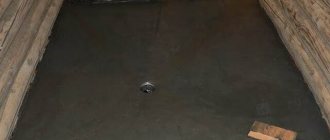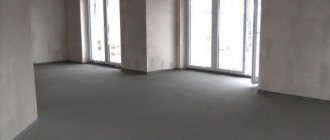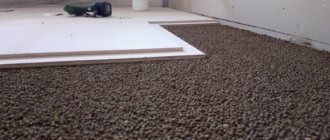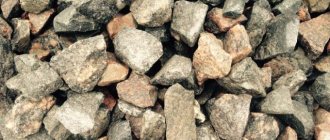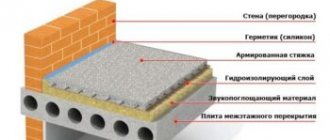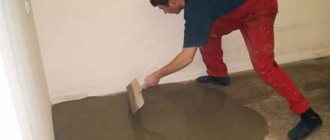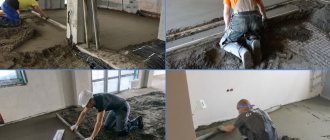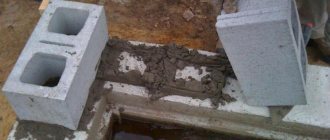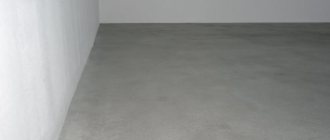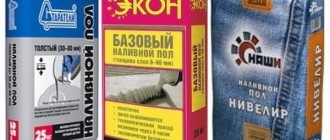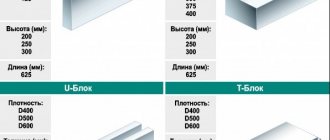An important part of the construction or renovation of a residential premises is the installation of flooring. Recently, mechanized dry floor screed has been increasingly used. Thanks to the use of modern technology and the absence of water in the solution, the coating takes place in a short time.
Functions of floor screed
A floor screed can perform many different functions. The main purpose of this element is to maximize the leveling of the final canvas, onto which the floor will subsequently be applied. It is unlikely that it will be possible to achieve an overly flat tiled surface, and without leveling it will not be possible to lay the floor covering. The floor screed is also used to bring the floor to the required installation level, which is calculated during the creation of the project.
Floor screed tools.
An element of such a plan will help provide a solid and durable foundation that is resistant to destruction and mechanical damage. If the house has a heated floor, then this process will protect the cable and pipeline, and also correctly distribute the heat over the entire surface of the canvas.
If the floor screed was installed carelessly, this may subsequently lead to cracking and uneven shrinkage of the canvas. Such factors lead to deformation of the coating. For this reason, it is necessary to carefully prepare for such a process, acquire the necessary components, calculate the thickness of the screed, and follow all established work standards. It is best to use special dry mixtures when forming it.
Application process
The thickness of the screed and the materials used depend on the technical parameters of the building, so it is necessary to know the maximum possible load on the foundation and foundation. Cement-sand mixtures are used for the mortar; usually grade 150 cement is used for such work. Such a mortar is laid on the base using a vibrating screed.
Floor installation with semi-dry screed.
Before you start laying out the solution, you need to check the base and, depending on the results, determine the required solution. The thickness of a mechanized semi-dry floor screed depends on the specific coating tasks. If you want to lay a covering with the same height in each room of the house, then calculations of the thickness of the screed must be carried out separately for each room, taking into account the thickness of the finishing layer.
In general, preparing the surface is one of the most difficult tasks in the screeding process. If there are cracks and gaps between the plates, they are covered with a solution, the surface itself is cleaned of debris and dust, treated with a degreasing solution and a primer is applied.
DURING PREPARATION OF THE SURFACE FOR THE SCREED, A LAYER OF WATERPROOFING IS MADE ALONG THE WALLS, THIS IS NECESSARY SO THAT WHEN DRYING THE SCREAD, THE WALLS DO NOT ABSORPTE MOISTURE.
Also an important part of the preparation will be the calculation of the zero level of the screed, which will subsequently indicate the maximum level of mortar filling. Previously, a water level was used to calculate the zero level, but now laser, more accurate levels are in use.
After preparation, pouring and distribution of the mixture will follow. The best option would be to fill the entire room in one day, so as not to create seams between areas. However, if breaks cannot be avoided, then the seam will certainly be left in order to avoid cracks.
Laying using a vibrating screed.
Using vibrating slats, the mixture is compacted, and it is most accurately leveled with a leveling squeegee. All work on semi-dry screed must be carried out without interruption, otherwise possible errors and temporary inconsistencies may cause deterioration of the final screed.
If a semi-dry floor screed is created exclusively by mechanized methods, then the solution is prepared at the construction site using special equipment. The finished mixture is transported to the site to be poured at a distance of up to 160 meters, and if an apartment on the upper floors is poured, the distance is reduced to 100 meters.
Types of floor screeds
Floor screed is divided into several types according to the following parameters:
- manufacturing technology;
- number of layers;
- method of connection to the canvas.
Manufacturing technology involves the use of wet or dry technology. To form the first, you need to prepare a mixture using cement and sand or use a dry mixture containing gypsum and cement. A similar solution is poured onto the surface and then leveled. In the case of sand and cement, additional reinforcement will be required. The wet method is a universal option that can be performed using completely different technologies. It is extremely popular in domestic construction. The thickness of such a screed can range from several millimeters to 10 cm.
Floor screed diagram.
The dry version consists of large slabs and sheets that have a thickness of 15 to 30 mm. As a rule, fiberboard is used as a consumable material. Such a screed has a significant disadvantage: it will not allow for comprehensive leveling of the surface if the latter has significant differences in levels. That is why this type of screed is often used together with a wet one and applied on top of the latter. Mechanized semi-dry floor screed is the most advanced type of floor leveling. With this method, the mortar is prepared at the construction site, and its mixing, transportation and supply are performed by special construction equipment. Mechanized floor screed speeds up and simplifies the entire process.
The number of layers in a screed can vary from one to several. If the latter option is selected, then it includes roughing and finishing levels. For example, when forming a floor, a rough concrete screed is applied, then the leveled finish is used as finishing. To form the latter, it is best to resort to a self-leveling mixture. The rough version must have a thickness of at least 20 mm, the finishing version must have a thickness from 3 to 20 mm.
The connection method involves a solid screed that firmly adheres to the previous layer, and a floating screed that is not connected to the floors. The second option is chosen if it is necessary to form a waterproofing film. Its thickness should be 35 mm or more.
Tools for work
In this video you will find a master class on laying semi-dry mechanized floor screed.
To carry out such an event, the following is required:
- Building level - to control the level horizontal part.
- Squeegee - to level the screed. Such a tool may have the ability to adjust layer parameters.
- The rule is for leveling screeds made of cement and gypsum.
- Needle roller - to displace air bubbles from all layers.
- Special shoes that have a sole with nails.
Is it appropriate to compare these two methods of floor leveling? And who should do this comparison and why is it needed?
I will answer this way, there is nothing even to compare. After all, it would be correct to say that the method of leveling the floor should be selected by the engineer or designer who draws up the design documentation or the specialist who manages your facility and completely entrust them with this choice and decision on the use of one method or another!
READ MORE: DSP boards for flooring: application, properties
The first method and the second are the same traditional way of leveling the floor using a solution based on cement and sand, in the first case a tool is kneaded, in the second a machine, in both cases a person controls the entire process.
- Our company had experience using its own mechanized machines.
- We have attracted and are attracting specialized companies for mechanized floors.
- We ordered the solution from factories and are ordering the same.
- We have made, are making and will continue to make traditional screeds by preparing the mortar on site.
Already from this small list, one can conclude that I do not place emphasis on the fact that any type of these sexes is worse or better, that one is superior to the other, and so on, I repeat, in all cases it is all the same!
The point is that each of the types, or more correctly, methods, is suitable and ideally applicable to its own conditions and tasks. Let's consider all the important components that may concern both the customer and the contractor; in the latter case, we need to make an offer that would be difficult to refuse, so that it is of high quality and does not affect the timing of the work.
I put price and quality first. The price under equal conditions in the first and second options, the material and work will be almost equal! In the first and second cases, the material is purchased directly from suppliers; when preparing concrete, M500 cement is used, and as a result of mixing, we obtain a ready-made mortar of M150 or M300; again, I will not go into the technology.
The point is that you need to sell your product, your way, even if it is the same thing.
One of these advantages is the elimination of leakage! Of course, but the amount of water added to the solution is also lower and the fluidity of the solution itself is lower, and this is not always an advantage. A competent craftsman will prepare the semi-dry screed for you by hand.
And again the answer is, there are no details, the rule of conditions and tasks works here.
If we are making an underground parking lot, and its area amounts to thousands of meters, then without any doubt we use a mechanized method for preparing the solution, since the traditional method will lose many times over in terms of completion time. Moreover, the cost is equalized due to large volumes of work and supplies of materials.
To be fair, when we finish talking about cost, it is worth noting that in some cases traditional screeds may have additional costs for lifting the material, but! And in the case of dry mechanized screed, the height of the building affects its cost, and in some cases completely excludes its use with the impossibility of delivery to the upper floors.
What is the screed made of?
Scheme for pouring screed according to beacons.
If you need to quickly screed floors, you must use cement or gypsum. Sand, a mineral and polymer additive, which is designed to improve the parameters of the solution, are useful as a filler. After this, you just need to dilute the resulting mixture with water.
When answering the question why a screed is needed, it is necessary to mention what it can be formed from:
- Cement. The main advantage is resistance to moisture and versatility of use. The main disadvantages are the long drying process.
- Gypsum. A plastic, easy-to-apply material that dries quickly and is applied in a thin layer. But it is not suitable for forming a screed in a damp room due to its absorbent properties.
- Dry mixes. They contain all of the above elements and combine their advantages. Thus, they are an ideal material for such purposes.
- Leveling mixtures. They are useful when creating a rough screed, that is, for leveling the base.
- Self-leveling mixtures. Suitable for forming the final layer of screed, which should look perfect.
Technology
Laying a mechanized screed is possible not only for semi-dry mortar, but also for dry mixtures. The main thing is to choose the right tool and prepare all the components.
The process of pouring screed in an apartment or other room involves several sequential operations:
- Preparing the base. This step is one of the most important, since the strength of the future structure depends on it. It is advisable to pour the screed onto a base that is free of cracks and other damage. If they are present, it is advisable to first seal them with plaster or other solutions. After this, the surface is cleaned of dirt, and a waterproofing film is placed on it, which it is advisable to attach to the walls with a reserve.
- Marking the level of the screed. To do this, they use beacons that are mounted around the entire perimeter of the room. It is recommended to make all marks along the walls using a laser level. A damper tape must also be attached along the entire perimeter, which will absorb the expansion of concrete without allowing the floor to collapse.
- Filling the floor with concrete. This occurs using the previously described technology for preparing and supplying the solution. It is important to distribute the mixture evenly over the surface so that you do not have to add it later.
- Compaction and leveling. At this stage, a screed layer is used, which consists of a frame and guides. The structure is installed directly into concrete and occupies a certain width. Then the vibration compactor is turned on and the carriage with the compactor begins to move. At this point, the mixture begins to thicken evenly. When the system has leveled one part, it is moved sequentially across the entire area of the room. It is advisable to lay concrete in one room at a time to form a strong and solid slab. All strips where the guides were located should be aligned independently upon completion of work. For this, the same rule and concrete are used.
- Grouting and sanding the top layer of the screed. This process is carried out 2 hours after pouring. During this time, the solution will have time to acquire little strength. Grouting occurs using special mechanisms, which also differ in power and control method. The quality of grinding with such a tool is very high, which allows you to perfectly level the top layer.
- Cutting expansion joints. They are formed using special cutters over the entire area of the room. Often the seams are arranged in large squares. But their specific placement depends on the structure of the building.
- Film protection. This is necessary to maintain optimal water balance on the surface of the screed.
The technology for producing a mechanical screed is quite simple, which allows it to be used both in winter and summer. The main thing is to properly create the indoor microclimate.
Preparing the base for the screed
You should pay attention to how the surface is prepared. It consists of several points:
Stages of finishing floor screed.
- The thickness of the screed is calculated and a line is drawn at the place where it is formed. For this purpose, it is enough to make a horizontal mark on the wall.
- The surface to be applied must be thoroughly rinsed with water. This is necessary in order to remove particles of dust and dirt.
- If you need to screed using sand and cement, then additional reinforcement is needed.
- It is necessary to install elements such as beacons, which will help to correctly fix the element horizontally and determine its level.
- If a machine screed is used, the share of manual labor is minimized.
What should a quality screed look like?
Scheme of screed reinforcement: 1 – main mesh, 2 – additional reinforcement of the main mesh, 3 – U-shaped reinforcement of the edges of the slab, 4 – L-shaped reinforcement of the corners of the slab, 5 – load-bearing walls.
To install the screed correctly, you need to know some conditions under which the installed element can be considered of high quality.
The first thing you should pay attention to is that the surface must be strictly horizontal. It is sometimes very difficult to achieve this value, but it is worth trying, since the durability and efficiency of the floor depends on it. A building level will be very helpful in this matter, as it will allow you to determine the slightest distortions in the structure.
The second is the formation of a perfectly smooth coating. Even the slightest unevenness can lead to deformation of the canvas, which will negatively affect its properties. This kind of point may not be fulfilled for ceramic and stone tiles, since such a factor does not matter to them. In other cases, it is best to use a grinding tool that will level the surface.
Third, the screed must be extremely strong and resistant to any mechanical damage. This item is formed exclusively when using high quality mixtures. Otherwise, the canvas will crack and diverge over time, and later the surface may even crumble, causing the floor to sag significantly. To achieve maximum effect in this matter, you can cover the floor with a special paint using acrylic, polyurethane or epoxy. A high-strength screed will not crumble even if you try to scratch it with sharp objects.
When is it necessary?
Mechanized screed is characterized by fast drying and high strength.
It is used in several cases:
- Construction of concrete floors that will be used without finishing. Often these surfaces are found in garages or warehouses.
- The need to strengthen old floors. This effect is achieved due to the fact that the concrete is compacted with special vibrating machines, and this allows the formation of a more durable structure.
- Formation of perfectly smooth surfaces. Very often, such screeds are made under laminate or parquet, which are very demanding in terms of height differences.
- Mechanical screeds are suitable for heated floors, as well as for those cases where it is necessary to ensure a high level of sound insulation of the floor.
- In some cases, you can hide communications under them that are laid for specific sources (pipes, electrical cables, and much more).
It should be understood that the previously described problems can be solved using classic screeds. But such surfaces will not be of high quality, and it is not always possible to control their technical characteristics.
Using a mechanized floor screed
Mechanical floor screed significantly reduces the time required for hardening.
This is because mixing uses only a small amount of water to hydrate the cement. After a day, the screed can already withstand active walking. Further finishing work at the site can be carried out after 4 days. After the mechanized floor screed has been carried out, you don’t have to worry about the need to level the surface.
Mechanical floor screed is now the most popular. With its help, it is possible to avoid unnecessary contamination. Its installation is carried out using a special trowel. In some cases, an automatic screed stacker is used. After this, the base of the floor becomes completely suitable for laying any material, be it parquet, linoleum, cork or tile.
Semi-dry screed - pros and cons
home | knowledge base | blog...It is correct to call a semi-dry screed mechanized. Together we will understand its advantages and disadvantages when carrying out renovations in an apartment.
We are proud that we not only make high-quality renovations in apartments and country houses (after all, for 18 years), but also educate in the literal sense of the word. It was the Attractive repair studio that encouraged the entire industry to abandon the term “semi-dry floor screed” and call this type of work the only correct name - mechanized screed. To say this is honest (and above all in relation to the customer). If you want to know the reasons for this, be sure to refer to the text at the link above (you can also see a photo of how such a screed is made). However, today we’ll talk about the pros and cons of mechanized floor screed.
Mechanized screed in general terms
To begin with, let us remind you: the screed is designed to make the base of the floor smooth and durable, and also to carry communications, if necessary, protecting them with its thickness and solidity. The screed is performed at the stage of rough repairs after the construction of interior partitions and plastering of the walls.
In apartments we perform both classical and mechanized screeding. In any case, we are talking about the so-called “wet processes in construction”. This means that in any case water is used to mix the mixture. Without her - nowhere!
Advantages of mechanized screed
Provided that technology is strictly observed and the equipment is in good condition, the advantages of mechanized (or, if you prefer, semi-dry) screed include the following circumstances:
- high productivity of work due to the mechanization of the procedures for mixing and distributing the mixture, as well as its subsequent compaction and smoothing;
- this means a reduction in the time required to complete such work, although the period of “drying” (strength gain) of such a screed is generally calculated using a formula that also applies to a classic screed, where the amount of water required to mix the solution is greater;
- the possibility of using volumetric reinforcement of the screed with fiber (such reinforcement helps prevent the formation of cracks in the first days after installing the screed);
- in some cases (but not always) - improvement of the heat and sound insulation properties of the floor.
What contributes to achieving such results? First of all, the composition. Yes, it seems that the mechanized screed is an ordinary cement-sand mixture. But it's not that simple. In addition, the composition includes fiber fiber (we have already mentioned it) and a modifier. The first component is made of very small thin threads (length 20–40 millimeters, thickness about 18 microns), and thanks to it, the strength properties are improved, which prevents the occurrence of cracks.
The second component increases the plasticity of the solution, which allows for more uniform laying of the screed.
As for the mechanization of the processes itself, which is also a plus of the “semi-dry screed” if the units used are in good working order, its description can be reduced to the use of a pneumatic blower and grinding machines:
The first mechanism is installed on the street (at the entrance or under the windows), where building materials are stored. There, the components of the future solution are mixed, and then they are supplied by a pneumatic compressor to the installation site using compressed air. The power of the pump allows the solution to be supplied to a distance of up to 180 meters horizontally and 100 meters vertically (i.e. to a height of up to the 30th floor).
The second mechanism allows you to carefully align the screed, achieving a high degree of evenness. This happens because sanding begins immediately after pouring.
Disadvantages of semi-dry floor screed
But unfortunately, not everything is perfect. Mechanized screeding also has a number of disadvantages.
The mechanisms used are quite expensive and require careful handling. Mechanized screeding can only be done with the help of specialists. Unfortunately, in the Moscow market for the provision of services related to the installation of cement-sand screeds, the majority of companies operate that use units that have previously been in long-term use. Such devices often do not allow mixing the solution in strict accordance with technology. This leads to inhomogeneity of the solution, uneven distribution of binder and filler, stalling and clumping of glass fiber when using volumetric reinforcement. As a result, you get a screed that requires repair, and in some cases, complete replacement. What is a complete screed replacement? This is the dismantling of the existing one, its removal and removal, as well as the installation of a new screed. Pleasure is not cheap.
Do you remember where the mechanized screed came to us in the form that is common among us now? You are right, from Western Europe. So, it is customary there to strictly follow the requirements regarding the physical and chemical characteristics of the components used. On the one hand, mechanization allows you to speed up the process of work, but on the other hand, it imposes additional (rather) strict restrictions on the components used. Humidity of sand and binder, aggregate fraction, strict weight distribution of construction chemicals (modifiers, plasticizers, etc.). In 80% of cases, it is customary to turn a blind eye to all this. It's sad, but the fact remains a fact. During the work of our bureau, we corrected more than a dozen ties made by would-be craftsmen, who thought that all these requirements were drawn up only to fill in the blanks in construction textbooks.
Mechanized screeding, performed by a company that specializes only in this type of work, is done quickly. Let's not argue with this. But what to do with this screed later, when the craftsmen, having completed their work, left, leaving you alone with this miracle. But it is precisely at this stage that the very sacred act for which the screed is used begins - the gradual interaction of the binder and water begins, the solution hardens, gradually turning into stone. For the proper course of this process, special conditions must be created. When the screed is made by our craftsmen during a comprehensive renovation, they continue to be on site, monitoring both temperature and humidity conditions.
Finally, let's talk about dirt. When starting a story with a mechanized screed, you should remember that the mixture is prepared directly on site. Sand is brought in in bulk. Bags of cement are also stored here. Management companies often prevent the implementation of such practices.
This is our story in a few words. If you want to know more or order the production of screeds or repairs in general, call us by phone or leave a request for a foreman to visit you.
